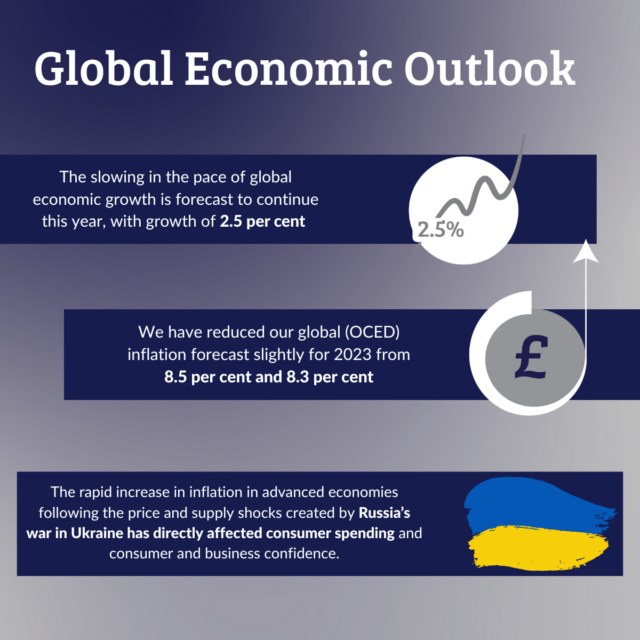Advanced Economies Face Slowdown and Stubborn Inflation
Globally, there is still work to do for central banks as they look to tackle underlying core inflation whilst navigate a slowdown in economic growth.

Growth in the world economy seems to be decelerating. In our last pre-Covid forecast we expected the world economy to grow 37.4% over this decade. It now seems that we will lose some $4.3 trillion of global output by 2030, compared with our expectations when the decade started.
This has two direct consequences. It becomes harder to think in terms of rapid universal increases in standards of living for the advanced economies. And increasingly it seems that the fate of the world economy, at least on the margin, is in the hands of the large newly industrialised, populous economies. Democracies and institutions have yet to adjust these new states of nature.
We expect this slower pace of global economic growth to continue this year, with growth of some 2.5% being the slowest (excepting the Covid-hit 2020) since the global financial crisis. This slowdown is most evident in advanced economies, some of which are likely to experience recession-like conditions. I am no fan of fixating on the zero line, as slightly positive or negative growth will mean a loss of real income for many and little progress for most.
The rapid increase in inflation in advanced economies following the price and supply shocks resulting from Russia’s invasion of Ukraine has directly affected consumer spending, as well as consumer and business confidence, which was still fragile as we emerged from the Covid cloud and a series of damaging supply chain failures. The very sharp, but necessary, tightening of monetary policies by the major central banks has exacerbated these effects.
Many raised concerns at the turn of this year about a much more abrupt adjustment in demand to negative supply shocks. But economic adjustment is now being helped by lower energy prices and accordingly slightly stronger readings for economic activity late last year and early this year, especially in China following the ending of lockdowns and in the US.
The rapid increase in headline inflation in advanced economies has resulted in the biggest surge in inflation for some 40 years. And has galvanised central banks finally to attempt a policy normalisation and reversal of unconventional monetary policies. Fortunately, inflation seems to be near its peak, aided by the reductions in commodity price inflation. But underlying or core inflation is proving persistent.
As a result, we have maintained a view that global inflation1 will be rather stubborn – at 8.3% for 2023 and 5.6% for 2024. Inflation is expected to remain elevated relative to pre-Covid target rates in advanced economies in the next two years because price pressures have broadened beyond volatile items such as energy and food. The escalation in inflation has provided a short-term focal point for wage and price setters far in excess of that consistent with price stability. However, lower energy and commodity prices and the effects of tighter monetary policies on demand will gradually feed through and lower inflation towards target in the medium term.
A spate of banking failures in the US and elsewhere has acted as a stark reminder of the fragility of financial systems in a period of rapid monetary tightening and increased the downside risks to our baseline projection. Any abrupt changes in monetary and financial conditions will tend to amplify the impact of higher policy rates. Central banks will therefore be mindful of such risks in their policy settings and are likely to be able take increasing comfort from falls in headline inflation as the year progresses.
We assume that the Federal Reserve will increase policy interest rates by a further 0.25 percentage points and the European Central Bank by 0.5 percentage points during the remainder of 2023. But, given that the pace of tightening we have already seen is contributing to the slow pace of economic growth, interest rates are pretty much at their peak. After such a long period of near zero policy rates, the sharp move back to recognisable levels represents something of a regime shift and therefore may be more deflationary than simple mechanical models may suggest.
Given the uncertainties about the direction and duration of the war in Ukraine, energy and food prices, and the domestic responses to higher inflation across many countries, monetary policy-makers will look for a sustained fall in inflation before they consider reducing rates. Our market-based assumptions suggest advanced economy central banks will not commence a reduction until early 2024, reflecting the stubbornness in underlying inflation.
There is a risk that policy-makers, worried about the perception of their being too slow to loosen policy, just as they were seen as having been too slow to tighten in 2021, will be tempted to reduce rates earlier. But policy activism does not mean rates should be marching up and down like the Duke of York’s 10,000 men. A prompt increase in policy rates to nudge demand back in line with hampered supply was all that was required. Once that is achieved and we expect inflation to return to something consistent with price stability, we should return to a state of vigilance.
